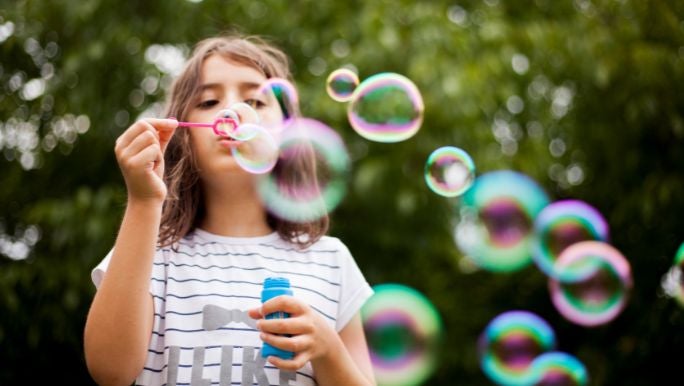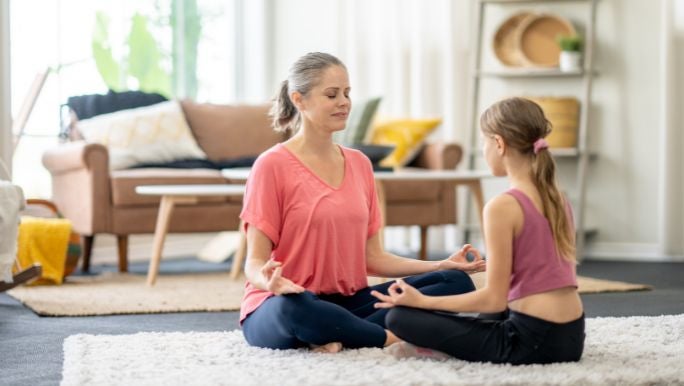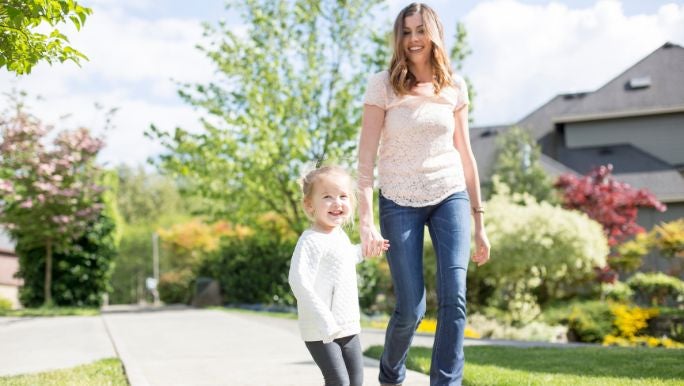Key Points
- Mindfulness is being aware of the present moment without judgement.
- The practice may help kids counter negative self-talk, calm mild anxiety and ease sleeping issues.
- Mindfulness activities for kids include walking, spending time in nature and blowing bubbles.
You may have heard that living in the moment and being mindful is good for your wellbeing. But does mindfulness also benefit children? We’ve discovered it’s never too early – or too late – to learn mindfulness.
So, what is mindfulness for kids, and does it work? We explore how mindfulness might benefit your children, how to introduce it to them and how to share mindfulness exercises with them today.
Is mindfulness for kids beneficial?
First of all, what is mindfulness? It’s often described as the state of being fully aware of the present moment and your thoughts and feelings, physical sensations and what’s going on in the world around you without making any judgements. Emerging research shows that mindfulness-based interventions may enhance physical and mental wellbeing and help people make positive changes.
Health Psychologist and Healthylife Advisory Board member Dr Moira Junge says in her clinical experience mindfulness practices have shown benefits for children.
“It helps them to be more present and notice what they’re experiencing,” she says. “It may help them to counter negative self-talk, mild anxiety, insomnia and strained relationships. Mindfulness can help children lean into self-compassion, confidence, restful sleep, and joyful and loving relationships.”
Both children and adults can benefit from mindfulness.
“Mindfulness practices help us to recognise, to be able to sit with and then in turn be better able to regulate negative emotions,” Dr Moira says. “The benefits are varied and relate to physical, mental, emotional and educational wellbeing. This may increase a child’s confidence and their ability to thrive.”
Dr Moira says studies have shown mindfulness may lead to:
- Increased focus, attention, self-control, classroom participation and compassion.
- Improved academic performance, ability to resolve conflict, and overall wellbeing.
- Decreased levels of stress, mild anxiety and disruptive behaviour.
Dr Moira adds that while research into mindfulness for kids is quite promising, more investigation needs to be done. “Research on mindfulness in schools is still in its infancy, particularly in relation to impacts on behaviour, academic performance and physical health.

Blowing bubbles can be used as a mindfulness practice for kids
How to help your child become more mindful
Australian not-for-profit Smiling Mind and parenting expert Maggie Dent have these tips on helping your kids become more mindful:
- Create time for calm by not overloading their schedules with activities.
- Ensure they get good-quality sleep.
- Be mindful yourself – stressed parents may create stressed children.
- If your child becomes upset, soothe them quickly and reassure them that they’re safe and valued.
- Teach your children that accidents and mistakes are OK.
- Spend time in nature.
3 mindfulness activities for kids
- “Take a mindful listening walk. Take your time and wander down your street, then ask your child to focus on what they can hear around them and what they can hear inside their mind while they’re on the walk. Get them to describe it to you afterwards,” says Dr Moira.
- “Even while they are brushing their teeth, ask them to take two minutes to notice what it feels like, what it sounds like and what smells are associated with teeth brushing. We often do routine things mindlessly, so this is a really purposeful mindfulness exercise,” she advises.
- “Good, old-fashioned blowing bubbles is a great simple mindfulness exercise. Blow bubbles and encourage your child to watch how far they go and all of the colours they can see in the bubbles. Focusing on one bubble and watching it go up in the air until it pops can be very mindful.”

Start small when introducing mindfulness to kids, such as a three-minute meditation
How often should kids practise mindfulness?
Dr Moira says it’s a good idea to start small when introducing mindfulness to kids. “Even a three-minute mindfulness meditation could be effective, but it depends on the child. And you would want to build on the duration and the frequency, according to the age and capacity of the child, and what they like doing.”
The trick is to keep it engaging. “Don’t make it too regimented or forced as it soon will become no fun and then unlikely to be something the child will take on as a lifelong habit,” advises Dr Moira.
Become more mindful today
Mindfulness is a valuable skill that may benefit both adults and children. While the research around mindfulness for kids is still limited, it is worthwhile incorporating mindfulness activities for kids into family life. Explore more about mindfulness and other activities, such as kid-friendly affirmations and breathwork, which may help you and your kids today.
Related:
Dr Moira Junge, a healthylife Advisory Board member, is a registered, practising health psychologist with the added specialty of sleep. She has been in private practice for over 20 years and is the CEO of the Sleep Health Foundation and was a founding member of the Behavioural Management of Sleep Disorders Committee within the Australasian Sleep Association (ASA). Dr Moira was also Chair of the ASA Insomnia and Sleep Health Council (2008-2015) and is a full member of the Australian Psychological Society.
Reviewed by the Healthylife Advisory Board November 2023


